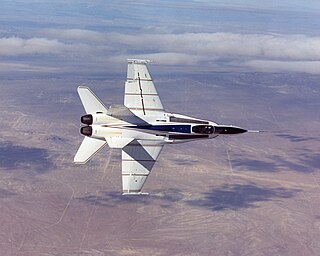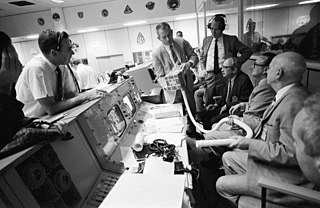Related Research Articles

Aeronautics is the science or art involved with the study, design, and manufacturing of air flight–capable machines, and the techniques of operating aircraft and rockets within the atmosphere. The British Royal Aeronautical Society identifies the aspects of "aeronautical Art, Science and Engineering" and "The profession of Aeronautics ."

Aerodynamics, from Greek ἀήρ aero (air) + δυναμική (dynamics), is the study of motion of air, particularly when affected by a solid object, such as an airplane wing. It is a sub-field of fluid dynamics and gas dynamics, and many aspects of aerodynamics theory are common to these fields. The term aerodynamics is often used synonymously with gas dynamics, the difference being that "gas dynamics" applies to the study of the motion of all gases, and is not limited to air. The formal study of aerodynamics began in the modern sense in the eighteenth century, although observations of fundamental concepts such as aerodynamic drag were recorded much earlier. Most of the early efforts in aerodynamics were directed toward achieving heavier-than-air flight, which was first demonstrated by Otto Lilienthal in 1891. Since then, the use of aerodynamics through mathematical analysis, empirical approximations, wind tunnel experimentation, and computer simulations has formed a rational basis for the development of heavier-than-air flight and a number of other technologies. Recent work in aerodynamics has focused on issues related to compressible flow, turbulence, and boundary layers and has become increasingly computational in nature.

Richard Travis Whitcomb was an American aeronautical engineer who was noted for his contributions to the science of aerodynamics.
The Royal Aeronautical Society, also known as the RAeS, is a British multi-disciplinary professional institution dedicated to the global aerospace community. Founded in 1866, it is the oldest aeronautical society in the world. Fellows and Companions of the society can use the post-nominal letters FRAeS or CRAeS, respectively.

Donald Wills Douglas Sr. was an American aircraft industrialist and engineer.
Energy–maneuverability theory is a model of aircraft performance. It was developed by Col. John Boyd, a fighter pilot, and Thomas P. Christie, a mathematician with the Air Force, and is useful in describing an aircraft's performance as the total of kinetic and potential energies or aircraft specific energy. It relates the thrust, weight, aerodynamic drag, wing area, and other flight characteristics of an aircraft into a quantitative model. This allows combat capabilities of various aircraft or prospective design trade-offs to be predicted and compared.

David Sloan Lewis, Jr. was an aeronautical engineer who led aerospace and defense giant General Dynamics for 14 years.

A gyrodyne is a type of VTOL aircraft with a helicopter rotor-like system that is driven by its engine for takeoff and landing only, and includes one or more conventional propeller or jet engines to provide forward thrust during cruising flight. During forward flight the rotor is unpowered and free-spinning, like an autogyro, and lift is provided by a combination of the rotor and conventional wings. The gyrodyne is one of a number of similar concepts which attempt to combine helicopter-like low-speed performance with conventional fixed-wing high-speeds, including tiltrotors and tiltwings.

The X-53 Active Aeroelastic Wing (AAW) development program is a completed American research project that was undertaken jointly by the Air Force Research Laboratory (AFRL), Boeing Phantom Works and NASA's Dryden Flight Research Center, where the technology was flight tested on a modified McDonnell Douglas F/A-18 Hornet. Active Aeroelastic Wing Technology is a technology that integrates wing aerodynamics, controls, and structure to harness and control wing aeroelastic twist at high speeds and dynamic pressures. By using multiple leading and trailing edge controls like "aerodynamic tabs", subtle amounts of aeroelastic twist can be controlled to provide large amounts of wing control power, while minimizing maneuver air loads at high wing strain conditions or aerodynamic drag at low wing strain conditions. This program was the first full-scale proof of AAW technology.

The Wright Brothers Medal was conceived of in 1924 by the Dayton Section of the Society of Automotive Engineers, and the SAE established it in 1927 to recognize individuals who have made notable contributions in the engineering, design, development, or operation of air and space vehicles. The award is based on contributed research papers.
Michael John Wendl is an engineer who worked at the McDonnell-Douglas Corporation, mainly in the area of aerospace control. He is noted primarily as one of the early developers of terrain following technology and a proponent of incorporating energy management theory into the design of fighter aircraft. He won the Wright Brothers Medal in 1974 with Ralph Pruitt, Gordon G. Grose, and J. L. Porter for a paper discussing future aircraft designs that integrate fly-by-wire controls with engine inlets/nozzles and advanced pilot displays.

Aerospace engineering is the primary field of engineering concerned with the development of aircraft and spacecraft. It has two major and overlapping branches: aeronautical engineering and astronautical engineering. Avionics engineering is similar, but deals with the electronics side of aerospace engineering.
V. Ralph Pruitt was an engineer at McDonnell Douglas who won the Wright Brothers Medal in 1974 with Michael J. Wendl, Gordon G. Grose, and J. L. Porter for a paper discussing future aircraft designs that integrate fly-by-wire controls with engine inlets/nozzles and advanced pilot displays.
Robert P. Johannes is an aeronautical engineer noted primarily as one of the developers of the control configured vehicle (CCV) concept. He won the Wright Brothers Medal in 1972 with Dwight Henry Bennett for the paper Combat Capabilities and Versatility Through CCV discussing its applications.
Dwight Henry Bennett was an aeronautical engineer and one of the early developers of the control configured vehicle (CCV) concept. He won the Wright Brothers Medal in 1972 with R. P. Johannes for the paper Combat Capabilities and Versatility Through CCV, discussing its applications.
John H. McMasters was an aeronautical engineer notable for his contributions to aerodynamics and engineering education.
Aerodynamics is a branch of dynamics concerned with the study of the motion of air. It is a sub-field of fluid and gas dynamics, and the term "aerodynamics" is often used when referring to fluid dynamics
Robert Hauschild Liebeck is an American aerodynamicist, professor and aerospace engineer. Until retiring from his position as senior fellow at the Boeing Company. in 2020, he oversaw their Blended Wing Body ("BWB") program. He has been a member of the National Academy of Engineering since 1992, where he is an AIAA Honorary Fellow, the organization’s highest distinction. He is best known for his contributions to aircraft design and his pioneering airfoil designs known as the "Liebeck Airfoil". Since his retirement he remains active in aviation industry associations and continues to teach at UCI.

John F. Yardley was an American engineer who worked for the McDonnell Aircraft Corporation and the National Aeronautics and Space Administration (NASA). He joined McDonnell in 1946, and contributed to the design and development of aircraft such as the McDonnell FH Phantom, F2H Banshee and F-101 Voodoo.
References
- ↑ "Gordon G Grose" . Retrieved July 4, 2021.
- ↑ Wendl, M.J., Grose, G.G., Porter, J.L., and Pruitt, V.R. (1974) Flight/Propulsion Control Integration Aspects of Energy Management, Society of Automotive Engineers paper number 740480.
- ↑ Gregory, J. (1980) Who's Who in Engineering, 4th ed., American Association of Engineering Societies.